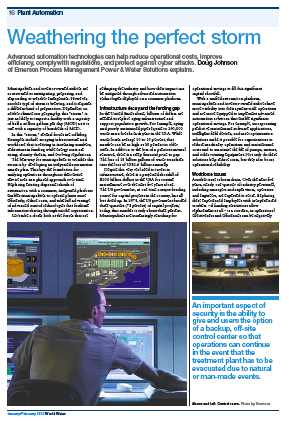 An Emerson Exchange 365 post pointed me to an article, Weathering the perfect storm, written by Emerson’s Doug Johnson for World Water magazine. The article’s synopsis:
An Emerson Exchange 365 post pointed me to an article, Weathering the perfect storm, written by Emerson’s Doug Johnson for World Water magazine. The article’s synopsis:
Advanced automation technologies can help reduce operational costs, improve efficiency, comply with regulations, and protect against cyber attacks.
Doug highlights the many challenges facing municipalities and investor-owned utilities including aging infrastructure, accelerating workforce retirements, increasing energy costs, security threat possibilities, and evolving regulations. In many water plants, existing islands of automation are increasingly difficult to operate given this set of challenges.
Doug notes that an integrated automation master plan can lay the foundation and provide a path for unifying operations in a phased approach over time. Doug writes:
Replacing existing disparate islands of automation with a common, integrated platform enables municipalities to operate plants more efficiently, reduce costs, and take full advantage of advanced control technologies that facilitate information sharing throughout the organization.
Over the past 30+ years, U.S. federal funding for these types of capital projects has dropped from over 75% to around 3%. From a maintenance perspective:
…there is a projected shortfall of $100 billion dollars in the USA for routine maintenance over the next five years alone.
The shift of capital and operational spending to the utilities means increased efficiency is paramount. Technology can help [hyperlinks added]:
Incorporating predictive maintenance software applications, intelligent field devices, and asset optimization solutions make it possible for organizations to reduce machinery operations and maintenance costs and to maximize the life of pumps, motors, and other rotating equipment.
For the accelerating loss of expertise these utilities are experiencing:
…automation solutions such as simulation technology, which help shorten the learning curve of new employees and therefore reduce the risk of errors and regulatory violations, are becoming even more important to municipal managers.
As a training tool, simulators teach operators to more safely and effectively operate their facilities. For example, they can try new operating procedures safely without risking an environmental breach.
Doug shares an example where a master plan incorporating an Ovation control system helped to optimize operations:
Previously, 160 operators were needed to manually operate the plant, whereas the automated Blue Plains facility now runs smoothly with 60 operators – a reduction achieved primarily through attrition and reassignment. The new control system also makes it easier to troubleshoot and resolve equipment problems, further boosting personnel and plant efficiency.
Water and wastewater treatment processes are energy intensive. From an energy management standpoint, process optimization solutions in control systems:
…can optimize a utility’s pumping network, determining the most cost-effective mix of available pumping resources at any given time. For example, the model can determine whether it is better economically to start an additional pump during peak demand periods versus incrementally increasing the capacity of pumps already in operation. Reduced energy use makes sense from an economic and environmental perspective, as it helps municipalities reduce carbon emissions.
From a security standpoint, integrated control systems [hyperlink added]:
…enable organizations to proactively address cyber security issues, such as system hacking, and data integrity and verification. Some control system vendors also help customers address security concerns through special services, such as security patch monitoring and deployment and system security assessments.
Doug concludes:
…a planned and integrated approach to automation makes it possible for municipalities and investor-owned utilities to maximize efficiency, reduce costs, and minimize security risks. The first step down this path is developing a long-term master automation plan, which serves as a roadmap for improving district-wide performance over time while also factoring in financial and operational constraints.
Give the article a read if you’re looking for ways to manage the current set of challenges in your water or wastewater treatment facility.




